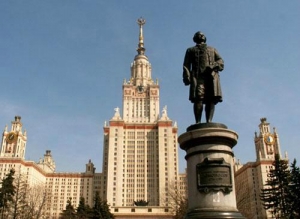Moskau +7-495-505-63-25
Sankt Petersburg +7-812-309-57-60
Excursions with Moscow University
Leninskie gogy Str., 1-A

Moscow State University is the oldest in Russia: in January, 2005 it celebrated its 250th birthday.
Moscow University was founded in 1755. Outstanding Russian scientist and Encyclopaedist Mikhail Lomonosov did his best to make the University foundation possible. Lomonosov was a staunch supporter of higher education in Russia, and his project was the fundamental one in the University forming. On January 12 (January 25, New Style), 1755 Empress Elizabeth signed the order, according to which the University was founded. It happened on the day when Russian Orthodox Church celebrates the day of Saint Tatiana. Since then Tatiana's day is celebrated as the day of Moscow University.
Originally, the University was housed in the drugstore building on Red Square. According to Lomonosov's plans, the three faculties were founded, which were Philosophical, Juridical, and Medicinal. Unlike European universities, Moscow University did not feature Theology faculty. The lectures in Moscow University were delivered not only in Latin that was the generally recognized scientific language, but also in Russian. The representatives of any class, except serf peasants, were allowed to enter the University. Originally the students were not supposed to pay for their studies, but later only poor students were allowed to attend classes free of charge. This politics determined democratic nature of Moscow University.
In a year after the University foundation the University library started to function. For over than 100 years it was the only public library in Moscow.
In 1786-1793 at the intersection of Bolshaya Nikitskaya Street and Mokhovaya Street the building for the University was put up. The impressive building was damaged during fire of 1812, and later it was rebuilt in the Empire style. In 1833-1836 on the opposite corner of Bolshaya Nikitskaya Street and Mokhovaya Street the new building featuring Saint Tatiana University Church was constructed.
Moscow University was extremely important for scientific knowledge popularization. On the basis of the University scientific societies were forming. Public was allowed to attend the University lectures and students' debates. In the University typography the newspaper «Moscow Vedomosti» («Moscow Bulletin») was published.
Many outstanding persons were studying at Moscow University. Among them were Decembrists A. and N. Muraviev, S. Trubetskoy, P. Kakhovsky, writers D. Phonvizin, V. Jukovsky, A. Griboedov, M. Lermontov, V. Belinsky, A. Gertsen, A. Chekhov, theater leaders V. Nemirovitch-Danchenko and E. Vakhtangov.
After the Great October Revolution Moscow University got the status of a state institute. The new chairs and faculties were organized. In 1940 when the University celebrated its 185th birthday, it was given the name of Mikhail Lomonosov.
In 1950 the new building of Moscow University was put up on Vorobievy Mountains. It was designed by architect L. Rudnev. In 1953 technical and natural faculties moved to the new building. In 1950-1970 the University complex was put up on Vorobievi Mountains. It housed all the faculties of Moscow State University, and only four faculties stayed in the buildings on Mokhovaya Street.
As international relations were developing, Moscow University turned into the large center of students' and candidates' training. In June, 1992 according to the President's order, Moscow State University got the status of self-governing institute of higher education.
Nowadays Moscow State University named after Mikhail Lomonosov is the largest classical university in Russian Federation. Over 40,000 students and candidates study at the University, and over 10 000 schoolchildren attend the preparation courses of the University annually. Many professors of Moscow University are laureates of Nobel Prize, State Premiums of the USSR and Russia.
Cultural and educational traditions of Moscow University are carefully kept by Moscow State University publishing house that issues scientific, popular scientific and training literature. Moscow State University Library is still the largest in Russia.
Two and a half centuries of Moscow State University work is a grandiose and precious contribution to Russian culture, science, and history.
Hotels in der Nähe
Golden Ring
Smolenskaya Str., 5
Das Hotel Solotoe Kolzo befindet sich in einem modernen Gebaude im historischen Stadtzentrum Moskaus nur wenige
ab 0
pro Nacht
Korston
15 Kosygina St.
The four-star Korston Hotel is situated in the well developed and ecologically favorable region of Moscow - on
ab 0
pro Nacht
Radisson SAS Slavyanskaya
Europe Platz, 2
Für Komfort, Bequemlichkeit und grossartige internationale Austrahlung gibt es keine bessere Wahl als das Radisson
ab 0
pro Nacht
Kebur Palace
32 Ostozhenka St.
The Kebur Palace Hotel with its 31 comfortable guestrooms is a hotel of choice for the traveler preferring the
ab 90.87
pro Nacht
Izumrud
3A Tatisheva St.
The Izumrud Hotel s staff is always ready to help the guests and make their rest unforgettable. There are 27 various
ab 0
pro Nacht
Sehenswürdigkeiten von Moskau
- Monuments
- Attractions











